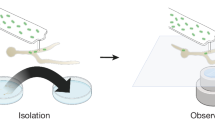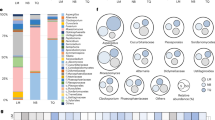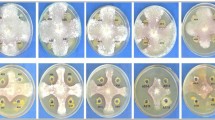Abstract
The rice seedling blight fungus Rhizopus microsporus harbors endosymbiotic Burkholderia sp. for the production of the virulence factor, the antimitotic agent rhizoxin. Since the toxin highly efficiently blocks mitosis in most eukaryotes, it remained elusive how self-resistance emerged in the fungal host. In this study, rhizoxin sensitivity was systematically correlated with the nature of β-tubulin sequences in the kingdom Fungi. A total of 49 new β-tubulin sequences were generated for representative species of Ascomycota, Basidiomycota and Zygomycota. Rhizoxin sensitivity assays revealed two further amino acids at position 100 (Ser-100 and Ala-100), in addition to the known Ile-100 and Val-100, which convey rhizoxin resistance. All sensitive strains feature Asn-100. This hot spot was verified by modeling studies, which support the finding that rhizoxin preferentially interacts with the tubulin molecule in a cavity near position 100. Ancestral character state reconstructions conducted in a Bayesian framework suggest that rhizoxin sensitivity represents the ancestral character state in fungi, and that evolution of rhizoxin resistance took place in the ancestor of extant resistant Zygomycota. These findings support a model according to which endosymbiosis became possible through a parasitism—mutualism shift in insensitive fungi.
Similar content being viewed by others
Log in or create a free account to read this content
Gain free access to this article, as well as selected content from this journal and more on nature.com
or
References
Birnboim HC, Doly J . (1979). A rapid alkaline extraction procedure for screening recombinant plasmid DNA. Nucleic Acids Res 7: 1513–1523.
Dale C, Moran NA . (2006). Molecular interactions between bacterial symbionts and their hosts. Cell 126: 453–465.
Einax E, Voigt K . (2003). Oligonucleotide primers for the universal amplification of β-tubulin genes facilitate phylogenetic analyses. Organ Divers Evol 3: 185–194.
Hall BG . (2006). Simple and accurate estimation of ancestral protein sequences. Proc Nat Acad Sci USA 103: 5431–5436.
Huelsenbeck JP, Ronquist F . (2001). MRBAYES, Bayesian inference of phylogenetic trees. Bioinformatics 17: 754–755.
Iwasaki S, Kobayashi H, Furukawa J, Namikoshi M, Okuda S, Sato Z et al. (1984). Studies on macrocyclic lactone antibiotics. VII. Structure of a phytotoxin ‘rhizoxin’ produced by Rhizopus chinensis. J Antibiot 37: 354–362.
James TY, Kauff F, Schoch CL, Matheny PB, Hofstetter V, Cox CJ et al. (2006). Reconstructing the early evolution of fungi using a six-gene phylogeny. Nature 443: 818–822.
Moran NA . (2006). Symbiosis. Curr Biol 16: R866–R871.
Moran NA, Baumann P . (2000). Bacterial endosymbionts in animals. Curr Opin Microbiol 3: 270–275.
Partida-Martinez LP, Groth I, Roth M, Schmitt I, Buder K, Hertweck C . (2007c). Burkholderia rhizoxinica and Burkholderia endofungorum, bacterial endosymbionts of the rice pathogenic fungus Rhizopus microsporus. Int J Syst Evol Microbiol 57: 2583–2590.
Partida-Martinez LP, Hertweck C . (2005). Pathogenic fungus harbours endosymbiotic bacteria for toxin production. Nature 437: 884–888.
Partida-Martinez LP, Hertweck C . (2007). A gene cluster encoding rhizoxin biosynthesis in Burkholderia rhizoxina, the bacterial endosymbiont of the fungus Rhizopus microsporus. Chembiochem 8: 41–45.
Partida-Martinez LP, Looß C, Ishida K, Ishida M, Hertweck C . (2007b). Rhizonin, the first mycotoxin isolated from lower fungi, is not a fungal metabolite, but produced by bacterial endosymbionts. Appl Environ Microbiol 73: 793–797.
Partida-Martinez LP, Monajembashi S, Greulich KO, Hertweck C . (2007a). Endosymbiont-dependent host reproduction maintains bacterial-fungal mutualism. Curr Biol 17: 773–777.
Posada D, Crandall KA . (1998). MODELTEST: testing the model of DNA substitution. Bioinformatics 14: 817–818.
Ronquist F . (2004). Bayesian inference of character evolution. Trends Ecol Evol 19: 475–481.
Ronquist F, Huelsenbeck JP . (2003). MrBayes 3: Bayesian phylogenetic inference under mixed models. Bioinformatics 19: 1572–1574.
Sato Z, Noda T, Matsuda I, Iwasaki S, Kobayashi H, Furukawa J et al. (1983). Studies on rhizoxin, a phytotoxin produced by Rhizopus chinensis causing rice seedling blight. Ann Phytopathol Soc Jpn 49: 128.
Scherlach K, Partida-Martinez LP, Dahse H-M, Hertweck C . (2006). Antimitotic rhizoxin derivatives from cultured symbionts of the rice pathogenic fungus Rhizopus microsporus. J Am Chem Soc 128: 11529–11536.
Steenkamp ET, Wright J, Baldauf SL . (2006). The protistan origins of animals and fungi. Mol Biol Evol 23: 93–106.
Sullivan AS, Plasad V, Roach MC, Takahashi M, Iwasaki S, Luduena RF . (1990). Interaction of rhizoxin with bovine brain tubulin. Cancer Res 50: 4277–4280.
Takahashi M, Iwasaki S, Kobayashi H, Okuda S, Murai T, Sato Y . (1987). Rhizoxin binding to tubulin at the maytansine-binding site. Biochim Biophys Acta 926: 215–223.
Takahashi M, Kobayashi H, Iwasaki S . (1989). Rhizoxin resistant mutants with an altered β-tubulin gene in Aspergillus nidulans. Mol Gen Genet 220: 53–59.
Takahashi M, Matsumoto S, Iwasaki S, Yahara I . (1990). Molecular basis for determining the sensitivity of eucaryotes to the antimitotic drug rhizoxin. Mol Gen Genet 222: 169–175.
Thompson JD, Higgins DG, Gibson TJ . (1994). CLUSTAL W: improving the sensitivity of progressive multiple sequence alignment through sequence weighting, position-specific gap penalties and weight matrix choice. Nucleic Acids Res 22: 4673–4680.
Tsuruo T, Oh-hara T, Iida H, Tsukagoshi S, Sato Z, Matsuda I et al. (1986). Rhizoxin, a macrocyclic lactone antibiotic, as a new antitumor agent against human and murine tumor cells and their vincristine-resistant sublines. Cancer Res 46: 381–385.
Vogelstein B, Gillespie D . (1979). Preparative and analytical purification of DNA from agarose. Proc Nat Acad Sci USA 76: 615–619.
Acknowledgements
We are grateful to M-G Schwinger and G Baumbach for fungal strain cultivation and preservation. Financial support by the DFG (ILRS, JSMC) is gratefully acknowledged. Data deposition: Tubulin sequences were submitted to GenBank at http://ncbi.nlm.nih.gov under accession numbers AY944765–767, 769, 772–773, 776–777, 783–784, 786–793, 795, 797, 800–803, 805–811, 813–814, 816-819, 824, 827, 829, 836-837, 852–856, 863).
Author information
Authors and Affiliations
Corresponding author
Rights and permissions
About this article
Cite this article
Schmitt, I., Partida-Martinez, L., Winkler, R. et al. Evolution of host resistance in a toxin-producing bacterial–fungal alliance. ISME J 2, 632–641 (2008). https://doi.org/10.1038/ismej.2008.19
Received:
Revised:
Accepted:
Published:
Issue date:
DOI: https://doi.org/10.1038/ismej.2008.19
Keywords
This article is cited by
-
Detection and isolation of a new member of Burkholderiaceae-related endofungal bacteria from Saksenaea boninensis sp. nov., a new thermotolerant fungus in Mucorales
IMA Fungus (2023)
-
Functional properties of Rhizopus oryzae strains isolated from agricultural soils as a potential probiotic for broiler feed fermentation
World Journal of Microbiology and Biotechnology (2022)
-
Investigation of presence of endofungal bacteria in Rhizopus spp. ısolated from the different food samples
Archives of Microbiology (2021)
-
Notes for genera: Ascomycota
Fungal Diversity (2017)
-
Influence of symbiont-produced bioactive natural products on holobiont fitness in the marine bryozoan, Bugula neritina via protein kinase C (PKC)
Marine Biology (2016)



